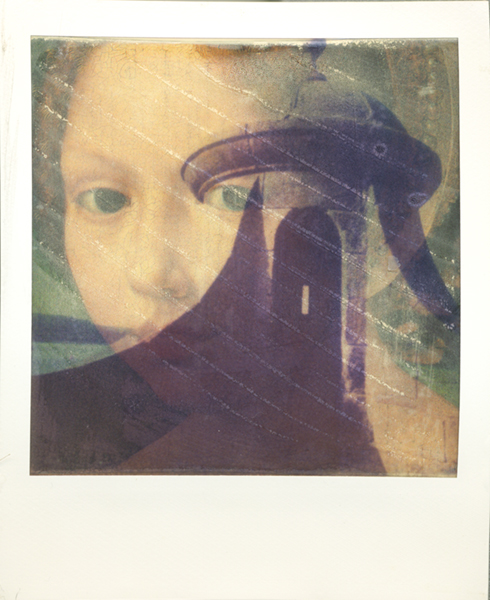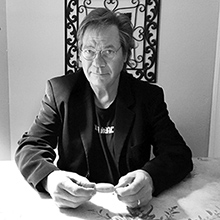Florian Kaps, one of the founding members of the Impossible Project recalls a conversation he had with John Reuter in 2007. Dr. Kaps was interested then in producing a worldwide “final project” for 20×24 with the last 100 cases of film. John Reuter, Director of the 20×24 Studio had other plans. Reuter has kept the 20×24 Studio alive with film purchased from Polaroid just for the 20×24 cameras. That film is now running out and doc and John once again are discussing his plan from almost nine years ago.
The Polaroid Polacolor Image Transfer process was extremely popular among photographers and artists in the 1990s and 2000s. Not many have seen Image Transfers as large as 5×6 feet. John Reuter began making 20×24 Image Transfers in the early 1980s and expanded the format in 1987 with his first 9 panel transfers mounted on canvas spanning 62 by 72 inches. Based on collage images in the pre-Photoshop era, these composites were transferred to watercolor paper and reworked with dry pigment, pastel and graphite. The resulting pieces resembled fresco panels in their scale and surface qualities. After creating several very large pieces he settled on the 4 panel format of 42×52 inches. With Polacolor film still offered by the 20×24 Studio these type of multi-panel pieces are still possible to create.
Back in the early 2000s, before Polaroid began its slow final slide, some very interesting products were released. The square peel part format was reborn, and the most amazing film was Type 85 Positive/Negative. A square cousin to the revered Type 665, this film was the alternative photographer’s dream. Coupled with the Holga camera and Polaroid back, Type 85 provided beautiful negatives in a fun and easy to use form factor. As a marketing manager for Professional Products in the early 2000s I got a chance to shoot with Type 85 on many occasions, my favorite shoots occurring in Florida, Santa Fe, NM and California at Point Lobos. I never considered myself a landscape photographer and using a handheld plastic camera offered a strange perversity for me. The images seemed to demand being warmed toned to me, evoking an antiquity that belied their instant heritage.
From SX-70 to Impossible
Nearly 40 years ago I made my first images with a Polaroid SX-70 camera. Initially influenced by the imagery and technique of Lucas Samaras I pursued the surface manipulation that the integral film allowed. In the fall of 1975 I was shown a technique that offered me many more possibilities. Fellow graduate student Rick Valicenti demonstrated his “emulsion stripping” technique where one carefully removed the negative from the integral packet, revealing the positive image under a layer of titanium dioxide. On a light table one could make out the outline of the image and with a swivel knife carefully cut around details of an image. Portions could be kept and portions removed, leaving clear polyester in the open areas which could be filled with acrylic paint or collage imagery. All work was done from behind but when the image was viewed from the front it presented a smooth and continuous image. This allowed fantastic or surreal imagery to be presented in a container that belied the content presented. It was as if these surreal scenes ejected from the SX-70 camera untouched.
I later discovered an additional technique of “emulsion transfer” by soaking the film packet in warm water and floating the dyes out of one frame and placing them into another. The introduction of water caused the dyes to swell and contract, leaving artifacts that greatly resembled the textures of the reticulation process taught to me by Michael Teres in the early 70s.
Fast forward four decades later and SX-70 film is long gone and the technique I employed abandoned since the early 1980s. Impossible Project brings back instant integral film in 2009 and while it lacks the image quality of Polaroid’s SX-70 film it does possess some of the plastic characteristics of emulsion manipulation. The film exhibits a very narrow exposure latitude but coupled with the Impossible iPhone printer I was able to achieve the quality I once had with Polaroid materials. Calling on all forms of digital and analog technique I have combined Photoshop collages with paper collages and acrylic paint inside these familiar SX-70 frames. The Impossible materials respond the familiar “stripping” technique and the introduction of moisture will also create a reticulation effect in the image. I am please to present these in this alumni exhibition as an homage to my professor, Michael Teres.




 Going Local in Lightroom 5 with John Reuter
Going Local in Lightroom 5 with John Reuter
Lightroom, with many powerful tools to control raw digital files, transformed the way photographers manage their images. Adobe has since added many local controls to fine tune and correct your images that have gotten so sophisticated that many photographers feel they can perfect their image without ever leaving Lightroom. You will explore the local adjustment and retouch tools of Lightroom, the Adjustment Brush, the Graduated and (new) Radial Filters, and the Clone and heal tools. Adobe has added the full range of global controls in the sliders for these local tools, greatly extending their power and flexibility. You will explore all of these tools and cover the ins and outs of masking in Lightroom, allowing you to get the maximum control of your vision.
Thursday, January 16 8:30-10:00 am
Photoshop Selections: Old School/New School, Which are You? with John Reuter
Making selections in Photoshop has always been one of the most important editing skills to master. In the early days, it was the Lasso, Magic Wand, and the venerable Pen Tool that helped us select certain pixels and not others. The star pupil of the New School, meanwhile, is the Quick Selection tool, a smart version of the Magic Wand, which you can train to quickly make a precise selection. Old School still has its place, and we will still explore Quick Mask editing to refine any selection; show how to save selections and load them later; and explain how to add to or subtract from a selection.
Friday, January 17 4:30-6:00 pm
DSLRs and then some: New Technologies for Personal Video with John Reuter
Sweeping new technology makes it easier not just to capture video — but to create stunning videos. Today, high quality video is available on cameras under $1000. The Canon 5D MkII revolutionized video, when it introduced full-frame HD video on a still camera. The GoPro Hero allows spectacular video to be captured virtually anywhere. And the Blackmagic Pocket Cinema Camera delivers HD video with 13 stops of dynamic range. Meanwhile, technologies such as Magic Lantern have extended those capabilities even farther, as has the ability to capture RAW video and process it though Adobe Camera Raw. John will demonstrate these advances with footage captured with the latest cameras.
Saturday, January 18, 4:30-6:00 pm


.jpg)

.jpg)
